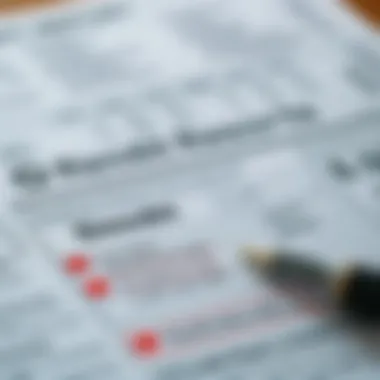Strategies to Remove Derogatory Marks from Credit Reports


Intro
Navigating the world of credit reports can be a daunting task. With the weight that derogatory marks carry, understanding their impact is essential. A credit report can significantly influence your financial life, from qualifying for loans to affecting insurance premiums. When negative entries appear, it’s crucial to act. Dealing with derogatory marks is about more than just numbers; it’s about reclaiming financial opportunities and securing your future.
Investment Terminology and Concepts
In order to tackle the issue of derogatory marks efficiently, it’s important to grasp some fundamental concepts and terms. Knowledge in financial terminology not only empowers you but also equips you to engage in meaningful discussions with financial advisors or lending institutions.
Key Terms Explained
- Credit Report: This is a detailed report of an individual's credit history prepared by a credit bureau. It includes information on credit accounts, payment history, and the presence of negative marks.
- Derogatory Marks: These are negative items on a credit report indicating financial distress, such as late payments, bankruptcies, or collections. Their presence can severely affect your credit score.
- Credit Score: A numerical representation of your creditworthiness, it ranges typically from 300 to 850. The higher the score, the better the terms you can expect when seeking new credit.
Investment Strategies Overview
In the context of managing derogatory marks, consider strategies that not only address immediate concerns but also promote long-term credit health:
- Regular Monitoring: Continuously check your credit reports from agencies like Experian or TransUnion. This helps ensure that no new derogatory marks pop up without your notice.
- Credit Repair Services: If handling this on your own seems overwhelming, you might explore services that specialize in credit repair. However, exercise caution and investigate their legitimacy before engaging.
- Effective Dispute Processes: Familiarize yourself with the procedure for disputing inaccuracies. Utilizing the Fair Credit Reporting Act (FCRA) can bolster your position when arguing against incorrect entries.
Steps to Removing Derogatory Marks
Understanding the path to remove derogatory marks is essential for anyone looking to improve their credit report. Here’s a general outline:
- Identify the Marks: Start by collecting your credit reports from all three major bureaus to see the derogatory entries.
- Gather Evidence: Compile any documentation that supports your case for disputing the marks, such as payment receipts or letters.
- Dispute Inaccuracies: Follow the guidelines provided by each bureau for disputing marks. You may write to them directly or use online platforms to initiate disputes.
- Follow Up: Keep track of your disputes. The bureaus usually have a 30-day timeframe to investigate your claims.
- Seek Professional Help: If disputes don’t yield results, consider consulting a lawyer who specializes in credit issues.
“Taking control of your credit is not just about clearing derogatory marks, but rather about building a foundation for your financial future.”
Understanding these components can paint a clearer picture of your financial landscape. Empower yourself with knowledge, and work diligently to restore your credit health. By knowing your rights and the processes involved, you play an active role in shaping your financial destiny. For resources on understanding credit and disputing inaccuracies, visit Federal Trade Commission or Consumer Financial Protection Bureau.
Understanding Credit Reports
Understanding credit reports is a crucial component in managing one’s financial health. It serves as a window into an individual's creditworthiness, helping lenders make informed decisions about loan approvals and interest rates. This article explores the details that make up a credit report and the role they play in shaping credit scores. A well-informed individual can better navigate the often murky waters of credit, and this section aims to shed light on that.
What is a Credit Report?
A credit report is a comprehensive document created by credit bureaus, detailing an individual's credit history. When a person applies for credit, lenders usually turn to these reports to gauge the risk involved in lending money. The report includes various details, from payment history to outstanding debts, helping to establish a borrower’s credibility in the eyes of lenders.
Components of a Credit Report
A credit report is not just a single entity; rather, it comprises several components that each tell a part of the story. Understanding these components can help demystify what might seem like an overwhelming document. Here’s a breakdown of the most critical elements:
Personal Information
This section includes identifying details such as name, address, date of birth, and social security number. The main purpose of collecting personal information is to ensure that the credit report accurately reflects the individual's credit history. A notable characteristic of this information is that it aids in uniquely identifying the individual and preventing the commingling of credit records. While this section may seem straightforward, its accuracy is vital as any discrepancies could lead to identity confusion or issues in securing credit. Having correct personal information can also prevent potential threats like identity theft.
Credit Accounts
Credit accounts reflect the various loans and credit lines an individual holds. This can include credit cards, mortgages, auto loans, and more. Each account entry typically provides details such as the credit limit, balance, and payment status. The primary function of this component is to illustrate the individual’s borrowing habits and capacity, showcasing how responsibly one manages debts. One distinct feature of credit accounts is their impact on the credit utilization ratio, which is crucial for determining a credit score. A good understanding of one's credit accounts can empower individuals to manage their borrowing effectively, thereby enhancing their chances of financial success.
Payment History
Considered to be one of the most significant aspects of a credit report, the payment history records whether past payments were made on time. Late payments, defaults, or any other negative marks can stick around for years, deeply affecting one’s creditworthiness. The key takeaway here is that this section provides insight into how reliable a borrower has been in meeting their financial commitments. One unique element of payment history is its weighted implications on credit scores; it typically constitutes about 35% of the score. Hence, maintaining a clean payment history is often viewed as a cornerstone of good credit management.
Inquiries
This section reflects the number of times a lender or creditor has pulled the credit report, split into hard and soft inquiries. Hard inquiries generally occur during credit applications and can impact the credit score negatively. On the other hand, soft inquiries may happen with credit checks by oneself or lenders for pre-approval offers. An important characteristic of this component is that too many hard inquiries over a short period can signal to lenders that the individual is a higher risk, leading to possible loan denials. The unique aspect is that while soft inquiries do not affect credit, hard inquiries can remain on the report for about two years.
"Understanding credit reports is like peering into a financial crystal ball. It helps you see past behaviors and guide future actions."
In summary, grasping the components of a credit report provides a solid foundation for understanding how credit works and what can be done to manage it better. Keeping tabs on personal information, understanding credit accounts, maintaining a positive payment history, and being mindful of inquiries can pave the way toward a healthier credit profile.
The Impact of Derogatory Marks
Understanding how derogatory marks affect your credit report is crucial in today’s financial landscape. For anyone trying to obtain loans, mortgages, or even certain types of jobs, a good credit score can often be the deciding factor. Derogatory marks can severely diminish your overall creditworthiness, making it imperative to grasp their implications fully.
Defining Derogatory Marks
Derogatory marks refer to negative entries on your credit report resulting from missed payments, bankruptcy filings, or other serious financial missteps. These marks can remain on your credit history for several years, tarnishing your reputation as a borrower. Typically, these entries alert potential lenders to past financial irresponsibility, which could hinder your chances of securing financing or may lead to higher interest rates when you do.


Effects on Credit Score
Short-term Effects
In the short term, a derogatory mark can slice a significant portion off your credit score. For instance, missing a payment can drop your score anywhere from 60 to 110 points, depending on your credit history. This sudden decline can lead to immediate changes in lending opportunities; banks and financial institutions could view you as a higher risk. Not to mention, landlords and certain employers might also look at your credit score before making decisions.
Long-term Consequences
Long-term consequences of derogatory marks are daunting as well. Once these marks appear, they can sully your credit file for up to seven years, depending on their nature. The key characteristic here is the lingering presence; even as time passes and consistent positive credit behavior is established, the shadow of a derogatory mark remains. This continued impact makes it more challenging to achieve favorable loan terms or, in some cases, even secure loans at all.
In summary, the implications of derogatory marks extend far beyond mere credit scores, influencing financial opportunities and the stability of one’s economic future.
It's vital to take action as soon as possible if you suspect that a derogatory mark is affecting your creditworthiness. By understanding both the immediate and lasting impact, consumers can better navigate the process of removing these marks and reclaiming their financial health. Addressing derogatory marks isn't just beneficial; it is essential for rebuilding your credit reputation.
Identifying Derogatory Marks
Identifying derogatory marks on your credit report is a crucial step in managing your financial health. Knowing what these marks are, where they come from, and their implications can set the stage for improving your credit score. In this section, we will explore the types of derogatory marks you may encounter and the ways to obtain your credit report for further analysis. Understanding these elements ensures informed decision-making, which is essential for reclaiming control over your financial situation.
Types of Derogatory Marks
Derogatory marks can take many forms. Their presence on your credit report can signal to potential lenders that you may be a risky borrower. Understanding the types of derogatory marks is vital, as they can vary significantly in terms of impact and resolution.
Late Payments
Late payments are among the most common derogatory marks. These appear when a payment is made after the due date. The key characteristic of late payments is their ability to accumulate, causing progressively larger impacts on your credit score. This signifies poor payment history, which can raise red flags for lenders.
The timeline is essential; a payment deemed late can reflect differently depending on how long it has been overdue. The unique feature of late payments is that they can often be addressed more easily than some other types of derogatory marks. For instance, if you're proactive in making payments on time afterward, the adverse effects can diminish over time. However, a significant disadvantage is that such marks can remain on your report for up to seven years, continually influencing your creditworthiness.
Bankruptcies
Bankruptcies represent a more severe form of derogatory marks. They indicate a judicial decision that you cannot meet your financial obligations. The stark characteristic here is their long-lasting effect—both emotionally and financially. Filing for bankruptcy can provide debt relief but comes at a high cost to your credit score and can remain on your report for up to ten years.
What makes bankruptcy unique is the fresh start it offers, allowing individuals to reinvent their financial life. However, this option is often a last resort and can severely restrict your borrowing ability during its effect. Understanding this process thoroughly is critical before making any decisions.
Judgments
Judgments come into play after legal action by creditors. If a borrower defaults on a loan, a lender may take them to court and win a judgment against them. The key characteristic of judgments is their public nature; this means they can impact your reputation beyond simply credit metrics. A judgment can indicate a serious inability to manage finances responsibly.
One notable feature of judgments is that they can often be disputed if inaccuracies exist. Yet, a judgment can linger in your records, making future borrowing a hassle, as it lets potential lenders view you as untrustworthy.
Collections
Collections are marked when debts are handed over to a collection agency for recovery. A significant characteristic of collections is their ability to snowball. Once a debt is in collections, it can lead to additional fees and a prolonged collection process, making it harder to resolve.
The unique feature of collections is that they might provide avenues for negotiation. For example, settling for less than what you owe may help clear the mark. However, being stuck in collections can lead to persistent calls from agencies and ongoing stress regarding unpaid debts.
Obtaining Your Credit Report
To effectively identify derogatory marks, obtaining your credit report is essential. It's the first step in ensuring your financial document aligns with your reality. Regularly reviewing your report can also help catch errors early on, aiding your credit management.
Free Annual Credit Reports
You are entitled to a free annual credit report from each of the three major credit bureaus. Key in this process is the accessibility; there are no fees, and you can request your reports via AnnualCreditReport.com. This is not just a beneficial option; it is essential to know what’s being said about you financially.
The unique bit about these free reports is that they allow you to spot inaccuracies without financial worries. However, relying solely on this annual review may leave gaps; you may require more frequent checks for ongoing concerns.
Online Credit Monitoring Services
In addition to annual reports, online credit monitoring services are invaluable for continuous monitoring. They offer real-time alerts about any changes, new inquiries, or derogatory marks added to your report. This characteristic of online credit monitoring is what sets it apart; it's proactive rather than reactive.
Though some services come with a subscription fee, they provide significant peace of mind compared to the anxiety of waiting for annual reports. The main downside might be the potential for reliance on these services to manage credit health actively, rather than developing personal accountability.
Steps to Remove Derogatory Marks
Removing derogatory marks from your credit report can seem like a daunting task. Still, it is essential for regaining your financial health and improving your credit score. These steps are vital because they provide a structured approach, enabling you to tackle inaccuracies and injustices that may be present in your report. A better credit report not only helps with loan approvals but can also lead to more favorable interest rates, which is a significant advantage for investors and financial advisors alike. Taking action can lead to the restoration of your credibility in the financial world.
Reviewing Your Credit Report
Analyzing entries


Analyzing entries in your credit report is the first step to accurately identifying derogatory marks. This process demands an in-depth look at each line item listed on the report. Each entry can spell the difference between a good credit score and a poor one. It's fundamentally important because understanding what exactly is on your report allows you to pinpoint problematic entries that might be artificially deflating your score.
The key characteristic of analyzing entries is the attention to detail required. It’s not enough to glance over entries; thorough examination ensures that you comprehend the implications of each entry on your overall credit health. While this can be a time-consuming process, the unique feature of this step is how it empowers you—awareness is half the battle. An advantage here is clarity regarding your financial standing, but the downside can be the emotional burden that often comes with confronting potentially negative aspects of your financial history.
Identifying errors
Identifying errors in your credit report is a crucial action that contributes immensely to removing derogatory marks. Mistakes can happen—whether through clerical errors or fraud, you must be vigilant. Errors can lead to a wrong assessment of your financial behavior and, consequently, your creditworthiness. When you identify these inaccuracies, you are essentially clearing the path to a cleaner report.
The key characteristic here is vigilance. This step is beneficial because spotting errors can lead to significant improvements in your credit score. Unique features of this process include the potential for errors that are more commonplace than people realize, such as incorrect account balances or accounts that do not belong to you. The advantages of identifying such issues quickly become clear: not only do you correct your report, but you also take proactive control of your credit health. However, the downside may be the need to navigate complex grievance processes, which can be frustrating.
Disputing Inaccurate Information
Filing a Dispute with Credit Bureaus
Filing a dispute with credit bureaus is the official step taken to correct inaccuracies once they have been identified. This action contributes directly to the goal of freeing your report from derogatory marks. When you file a dispute, you essentially ask the credit bureau to investigate the legitimacy of specific entries. This is instrumental because it allows you to formally challenge what may be incorrect or misleading information.
Its key characteristic is that it compels credit bureaus to act on your behalf. This method is popular because it offers a legally-supported way to address errors in your report. A unique feature of filing a dispute is that the bureau must respond to you within a given time frame, typically 30 days. The major advantage is that taking this formal step can hasten the removal of inaccuracies, but there are potential downsides as the dispute process can be lengthy and may require patience.
Preparing Necessary Documentation
Preparing necessary documentation is fundamental in supporting your dispute. This means gathering all required documentation that lends credibility to your claims. Whether it’s account statements, payment receipts, or correspondence with creditors, being organized helps build a strong case against disputed entries. This step plays a pivotal role in your overall goal of securing a clean report devoid of derogatory marks.
The key characteristic of preparing documents lies in the level of detail required. This is beneficial because the more comprehensive your documentation, the stronger your dispute will be. Unique features of this step include the potential to influence outcomes effectively; thorough documentation can tip the scales in your favor. However, it might prove to be time-consuming to gather all necessary documentation, which could feel like a burden amid an already stressful situation.
Negotiating with Creditors
Requesting Goodwill Adjustments
Requesting goodwill adjustments involves reaching out to creditors and asking them to remove derogatory marks as a favor—a goodwill gesture based on a solid track record of timely payments. This step is significant because it acknowledges that the mark may not reflect your overall creditworthiness. Goodwill adjustments can be a surprisingly effective way to lighten your credit report’s load.
The key characteristic of this method is personal communication. This can be beneficial as it builds relationships with your creditors, which can be advantageous down the line. A unique aspect of goodwill requests is that they often depend on your history with the creditor; long-standing customers may have better luck. However, the downside is that there’s no guarantee they’ll comply, leaving you at their mercy.
Settling Debts
Settling debts is another practical approach to removing derogatory marks from your credit report. This process involves negotiating with creditors to lessen your debt obligations in exchange for marking your account as paid. It contributes significantly to your goal by addressing the root cause of derogatory marks: unpaid or overdue debts.
Its most defining characteristic is how it permits a compromise, making it a beneficial choice if you’re unable to pay debts in full. The unique aspect of settling debts lies in the non-payment of your full debt amount, which can seem appealing. However, settling may lead to tax implications since forgiven debt can be considered taxable income. This aspect should be weighed carefully, as it might not be a straightforward saving after all.
Legal Protections and Rights
Understanding your legal protections and rights is crucial for anyone looking to improve their credit standing. These laws are designed to protect consumers from unfair treatment while ensuring accurate reporting. The Fair Credit Reporting Act, commonly known as FCRA, serves as a cornerstone of these protections. It grants consumers the right to access their credit reports, dispute inaccuracies, and ultimately seek recourse against harmful reporting practices.
The Benefit of Familiarizing Oneself with These Rights:
- Empowerment: Knowledge about legal rights helps consumers take control of their financial well-being.
- Recourse: If you find derogatory marks without basis in truth, understanding your rights allows you to dispute and potentially remove them, leading to improved credit scores.
- Accountability: Financial institutions and credit bureaus can be held responsible for inaccuracies, which encourages them to maintain better standards in reporting.
The FCRA provides an essential safety net, enabling consumers to engage confidently with credit bureaus and creditors alike.
Utilizing Professional Assistance
When dealing with derogatory marks on your credit report, sometimes the DIY approach simply doesn't cut it. Professional assistance can be a game changer. Seeking the help of credit repair services can offer nuanced insights and strategic actions that you might overlook. Not only do these professionals have experience navigating complex credit systems, but they also have well-honed skills in effective communication with creditors and credit bureaus. This section breaks down the considerations behind involving outside help.
When to Consider a Credit Repair Service
While some folks prefer to handle disputes on their own, practicalities often dictate that enlisting a credit repair service might be the better route. Situations where time is not on your side, or where the number of derogatory entries feels overwhelming, are classic examples to tap into these resources.
A few signs that a credit repair service might be necessary include:
- Multiple derogatory marks: If your report has various marks spanning different categories, a professional can efficiently address them.
- Limited knowledge: If navigating credit disputes feels like trying to thread a needle blindfolded, seeking expert advice could save you headaches.
- Time constraints: If your schedule is jam-packed, it’s often simpler to let professionals manage the intricate processes for you.
- Past unsuccessful self-dispute attempts: Finding that disputes filed on your own have yielded little to no results might give a good reason to consider professional help.
Evaluating Credit Repair Organizations
When choosing a credit repair organization, it's essential to scrutinize the options closely. Many claim to be able to help, yet not all live up to the expectations they set. Evaluating these entities involves looking at several factors, but two standout elements are transparency and understanding fees.
Assessing Transparency
A major characteristic to consider in any credit repair organization is transparency. It’s vital they are upfront about the services they provide and how they operate. An organization that willingly shares its methods and processes is typically one worth considering. Transparency can manifest through the following:


- Clear communication about what services they offer and the timeframes involved.
- Provision of client references or testimonials.
- Availability of detailed terms of service, so there are no hidden surprises down the line.
This clarity not only builds trust but also empowers you by keeping you informed throughout the credit repair process. A transparent organization often leads to a more favorable and satisfactory outcome, enabling a smoother path towards credit restoration.
Understanding Fees
Fees associated with credit repair services can vary significantly. Understanding these fees before moving forward is key to making informed decisions. Most organizations will use one of two structures: monthly subscription fees or pay-per-delete fees. Here’s how to navigate this aspect:
- Monthly Fees: This means you will pay a set amount every month as long as you continue using their services. It might be suitable for ongoing support but can add up quickly.
- Pay-Per-Delete Fees: This structure charges a fee for each derogatory mark successfully removed from your report. It can seem appealing because you only pay for results, but it’s crucial to understand what constitutes a success.
Understanding how these fees apply not only to your situation but also the potential long-term impact on your financial health is pivotal. Evaluate the cost versus benefits while keeping your budget in mind before making any commitments.
"Navigating credit issues is a maze. Professional assistance can help you find the exit more efficiently than going solo."
In essence, seeking professional help for credit repair should be a calculated decision hinged on your personal situation. When time, knowledge, or sheer volume of challenges loom large, these professionals can lend the expertise required to tackle derogatory marks head-on.
Building a Positive Credit History
Building a positive credit history is an essential aspect of overall personal finance. It doesn’t just apply to securing loans or credit cards; it reflects your ability to manage debt responsibly. When individuals focus on creating a strong credit history, they position themselves for better financial opportunities. Good credit history can help in securing lower interest rates on loans, making the difference between crippling debt and manageable payments.
Credit Accounts Management
Maintaining Payment Timeliness
When it comes to maintaining a good credit history, keeping up with payments is crucial. Timeliness in payments is one of the most significant factors that affect your credit score; missed payments can bring your score crashing down. Lenders view timely payments as a strong indicator of reliability. If you consistently pay on time, lenders are more likely to trust you with larger loans in the future.
A key characteristic of maintaining payment timeliness is setting up reminders or automating payments, which has become very common. It's a smart move for those who might have busy lifestyles. However, electronic payments can occasionally fail due to technical glitches, so always keep backups.
Advantages of keeping payments timely include improved credit scores, which can lead to opportunities like lower interest rates. However, relying solely on automation without regular oversight could also lead to missed errors, affecting your financial well-being in the long run.
Utilizing Credit Responsibly
Utilizing credit responsibly is not just about making payments on time; it's about knowing how much of your available credit you should be using. Ideally, it’s recommended to keep credit utilization below 30% of your total available credit. This simple action can significantly influence your credit score.
The key aspect of utilizing credit responsibly is balance. Keeping credit card balances low and managing how much credit you have without overextending is crucial. It shows lenders you’re financially savvy. However, some may argue that it limits some spending flexibility, which can be challenging.
One unique feature of responsible credit use is a diversification of credit types. Having different types of credit accounts, like a mortgage and credit cards, portrays you as a stable borrower. This carries its advantages too, but one downside is that applying for additional credit can temporarily lower your score, so it's best to proceed with caution.
Monitoring Your Credit Score
Monitoring your credit score is another critical step in building a positive credit history. The world of finance is dynamic, and your credit score can change quickly based on various factors. Regularly keeping an eye on your credit report ensures that you identify any issues early and can react promptly.
Using Monitoring Tools
Using monitoring tools, such as credit score apps or services, can provide you with real-time updates on your credit score. These tools can alert you to any drastic changes in your score, which helps you understand what affects it. Many financial institutions offer these tools for free as a benefit for their account holders.
The uniqueness of using these tools lies in their customization. Many allow you to set specific goals for your credit score, making it easier to strategize in the long run. However, relying too much on technology without understanding the fundamentals of credit management may lead you to overlook essential practices.
Regular Review Practices
Regularly reviewing your credit report is vital because mistakes can happen. If you don’t look at your report, you might miss important inaccuracies that could hurt your score. Regular reviews can help cultivate a positive credit history by allowing you to dispute any erroneous information promptly.
The important characteristic of this practice is its proactive nature. Consumers who review their credit reports frequently are better positioned to manage their credit effectively. However, this process can sometimes be tedious, leading some individuals to neglect it altogether. Still, the benefits far outweigh the drawbacks—keeping your credit history clean is always worthwhile.
"By establishing good habits now, you can avoid the pitfalls that come from poor credit management. A solid credit history acts as a springboard for future financial opportunities."
Culmination
Navigating the landscape of credit reports can be quite a task, especially when derogatory marks make an unwelcome appearance. The importance of effectively removing such marks cannot be overstated. It’s not just about clearing blemishes off a report; it’s about reclaiming financial opportunities. Whether it’s for getting a mortgage, securing a loan, or simply bolstering your overall financial health, a clean credit report plays a pivotal role.
Understanding the processes involved in removing derogatory marks allows consumers to take control of their financial destinies. This article has covered various aspects such as identifying derogatory marks, the steps required to dispute them, and the rights consumers have under the law. The information provided is designed to empower individuals to act decisively against inaccuracies that could otherwise impede their financial progress.
In short, the journey to a better credit report is not merely a procedural chore. It requires careful attention, negotiation skills, and sometimes, a professional touch. Yet, the payoff—a healthier credit score and access to favorable financial products—is well worth the effort.
Summary of Key Points
- Derogatory marks negatively impact credit scores and can hinder important financial opportunities.
- Identifying different types of derogatory marks, such as late payments, bankruptcies, and collections, is essential for formulating a removal strategy.
- Consumers have the right to dispute inaccuracies on their credit report and seek corrections.
- Building a positive credit history involves managing credit accounts responsibly and monitoring credit regularly.
- Engaging with credit repair professionals can be advantageous in navigating complex disputes, though it's crucial to evaluate their practices thoroughly.
Final Thoughts on Credit Management
Managing credit is not a one-time affair; it's an ongoing commitment that requires diligence and knowledge. As you work towards removing derogatory marks, consider this an opportunity to reassess overall financial habits. Maintaining timely payments, understanding how credit utilization affects your score, and keeping a vigilant eye on your credit report can all contribute to healthier financial outlook.
It can feel like steering a ship amidst rough waters, but with the right tools and knowledge, navigating credit management becomes much more manageable. Over time, these efforts can create a solid foundation for future financial endeavors. Therefore, it's not just about closing a chapter—it's about ensuring that the next one is filled with promise and potential.
For further details on monitoring your credit report, consider visiting resources like Annual Credit Report, where you can access your reports yearly without any cost.



